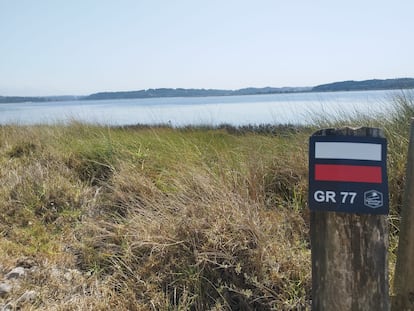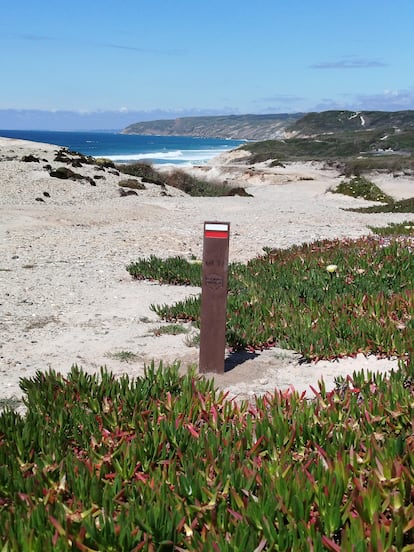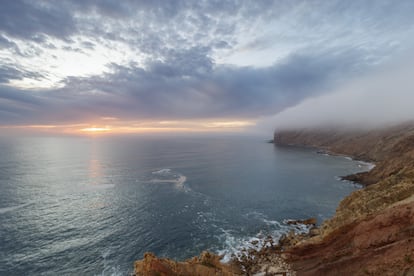The world's longest circular trail takes its first step in Portugal.

The path never advances alone. The ocean accompanies it, always there, inseparable. You don't even have to turn your head: the trail winds through the breeze, the smell of salt, and the sound of breaking waves. An immense blue horizon watches over your every step, from the left. To the right, bushes, small houses, and land paint the route green, white, and red. You have to detour a little to find another presence, less obvious, but no less colossal: on a stone rest the footprints of dinosaurs, which also roamed here millions of years ago. And at the end of the journey, an hour and a half later, two more encounters await: the perfect shell of sand and sea that forms the bay of São Martinho do Porto, on the central coast of Portugal; and the remains of a port where ships were built that Vasco da Gama set sail for the Indies. Or so the legend goes. The view truly takes your breath away.
In a few weeks, another ambitious journey begins in these lands. The opening of the first sections of Palmilhar Portugal, which aims to be the longest circular trail in the world, is scheduled for October: some 6,000 kilometers between mountains and beaches, forests and vineyards, villages and lagoons. EL PAÍS spent three days—with the collaboration of the organization—tracing the initial steps of a route that promises, within five years, to unite tourists and haters: a sustainable and authentic route, for everyone and every month of the year. From the interior to the coast, and back again, in search of exploration, discovery, nature, culture, and history. Although the word perhaps most often used by Ricardo Bernardes, the project's driving force, is "interaction." With the land and, above all, its people.

“Besides ‘ooooh, what a landscape,’ I would like visitors to think ‘ooooh, what a connection.’ If this manages to bring some life to less-traveled areas, it will make me happy,” he defines. He doesn’t want to be rushed, nor a list of destinations to fill in a hurry. On the contrary, he imagines encounters popping up around every corner. First and foremost, with the locals, always ready to offer at least a “ good day ” to the stranger; but also with festivals, concerts, exhibitions, guided tours, and other cultural activities that should spring up along the itinerary, according to Bernardes. Perhaps the essence of Palmilhar Portugal can be summed up in two decisions: he will exclude Lisbon and Porto, in the “most difficult” choice he has made; at the same time, he wanted to include a village where two shepherds live with dozens of goats. The hope is that they will cross passes with some hikers. During a walk through the Aire and Candeeiros mountains, another flock enlivened the path. A pair of rams were walking with their legs tied together to avoid being rammed. However, another collision did occur: the astonishing simplicity of the moment.
Bernardes is convinced that the 14th most visited country in the world—according to the World Tourism Organization—hides many such gems, far from its most famous cities and towns. “We are a small nation, but in just 150 kilometers you can find completely different landscapes and enormous cultural diversity,” he emphasizes. Like spectacular deserted sandy beaches in the middle of August; some 370 original meters of a 1st-century Roman road near Alqueidão da Serra; or an atelier dedicated to the most unexpected of crafts : desserts. In a couple of days, the route climbs hills and brushes past bathers, crosses rivers, and passes local fairs. It brims with variety and unlikely alliances. Like a cardinal sin transformed into art by the monks of Alcobaça, celebrated pastry chefs; or a ruined monastery overlooking acres of vineyards: who knows what Our Lady would say? Or novels and vegetables for sale together in a bookstore in the medieval village of Óbidos. “Leave only imprints; collect experiences; take home memories,” reads a tourist brochure for this town.

To fill visitors with memories, Bernardes is working full-speed ahead. Although, right now, Palmilhar Portugal also requires stamina and imagination . The former is assumed by any mountaineer, and by any project of this magnitude. A creative vision, on the other hand, serves to bridge the gap that still separates the first step from the horizon: for now, the plan has six participating municipalities (such as Alcobaça, Alenquer, and Óbidos ) of the 100 it hopes to add; it will have a mobile app with a map and real-time notifications about the nearest points of interest and events, but we'll have to wait until early 2026; and the signs made with sustainable materials are installed only in certain sections. At the Óbidos lagoon, a child starts a family game of petanque by throwing the ball far. Bernardes' project is also underway. Now it's about continuing to successfully introduce new features. Although the promoter seems to have a clear path.
Every so often, he stops to explain: “The trail will go through here, and then on to there.” He built the entire initiative with a personal investment ; he wants it to only cover public land, with municipalities providing only an initial fee to get the trails in each area up and running. From there , his business model calls for small commissions from hotels, restaurants, or any other establishment willing to participate, with cultural events and activities as the main source of income. Bernardes acknowledges the risks and difficulties, but shies away from shortcuts. Faced with suggestions of naming his project in English, he chose a synonym for “walking” in Portuguese. And among the few famous places Palmilhar is considering visiting is the shrine of Fátima, just a few kilometers from here. Perhaps, in return, the Virgin will lend her blessed hand. Marathon runners have already contacted Bernardes to be the first to walk the entire route, when it's available. He's happy, but advocates for a slower pace: “Little by little.”

The same one that wants to imprint on the path. Only those who pass slowly will notice marks on some of the walls of the Santa Maria de Alcobaça Monastery, a UNESCO World Heritage Site : workers in the 12th century were paid by the piece rather than by the hour, hence their time clock . The other side of the building , converted into a five-star hotel by Pritzker Prize-winning architect Souto Moura, reinforces the message: even the luxury of the service is imbued with minimalism and slowness. It also takes a while to spot birds in the Óbidos lagoon or discover that a restaurant in the village, Literary Man, serves dishes inspired by famous books and comics. A debate over who produces the best ginja , the local liquor; cheese delicacies for sale in an unassuming shop inside a gas station; a church covered in tiles: the best secrets only come to light with time to reveal them. Sitting and waiting for the delicacies in any tavern in the country is a good tasting experience. In every sense.
Palmilhar invites you to walk slowly. Although, inevitably, you bump into the surrounding crowd. To order a cabana on the beachfront at Bom Successo, the waiter asks to use English, where he feels more comfortable. The same language that pushes Portuguese aside in some Óbidos shops . Or that invites you to buy luxury apartments near São Martinho do Porto. “Twenty years ago, there was practically nothing here,” Bernardes notes, as he drives past exclusive homes mostly owned by foreigners. His own dream of buying a plot of land on the nearby cliff was long since buried by rising prices.
Only in these areas does the ruivaco fish swim and the ill-fated pig, the pride of the village of Alcobaça, grunts. But here too, the invasion of the profitable, yet non-native eucalyptus has arrived. It has even conquered lands previously dedicated to typical specialties such as pears, apples, and wine. Incidentally, white and rosé varieties are also grown in Portugal, as opposed to red. And during August, just like in Spain, entire forests burned. Reminders of how the planet is warming. And that a different kind of tourism is not only possible, but necessary. The ice factory that the Romans built two millennia ago in the Sierra de Montejunto to combat climate change isn't enough. Celestina, a cashier at a local supermarket, isn't clear on the solution to the world's frenzy, although she does have a clear diagnosis. She snaps at the queue of grumbling customers: "You all look like Mondays. Did you work this weekend or something?"
The grueling battle of our daily lives. Hence, Palmilhar Portugal prefers to recount other battles. That of Aljubarrota, where local troops defeated the crown of Castile and León in 1385, which is reenacted every August in the town of the same name. Or the eternal struggle of Pedro and Inés, another emblem of Alcobaça, a blend of Game of Thrones and Shakespeare, but made real. So much so that T-shirts with their names are sold around the town, along with two others, crossed out: Romeo and Juliet.
In the 12th century, the Portuguese prince began a relationship with his wife's Galician lady-in-waiting. When Constance died, both lovers saw the path clear to formalize their affair. King Afonso, however, took a dim view of the new union. So, in his son's absence, he ordered her to be eliminated. The enraged Pedro held back his desire for revenge until his accession to the crown: then, he ordered the murder of his beloved's executioners, exhumed her, finally placed her on the throne, and forced the entire court to kiss her decomposed hand. Today, both lie in the monastery of Santa Maria de Alcobaça, facing each other, by order of Pedro I. Thus, the end of the world will find them together. At this frantic pace, there doesn't seem to be much left. Unless we start to palm off along other paths.

EL PAÍS



